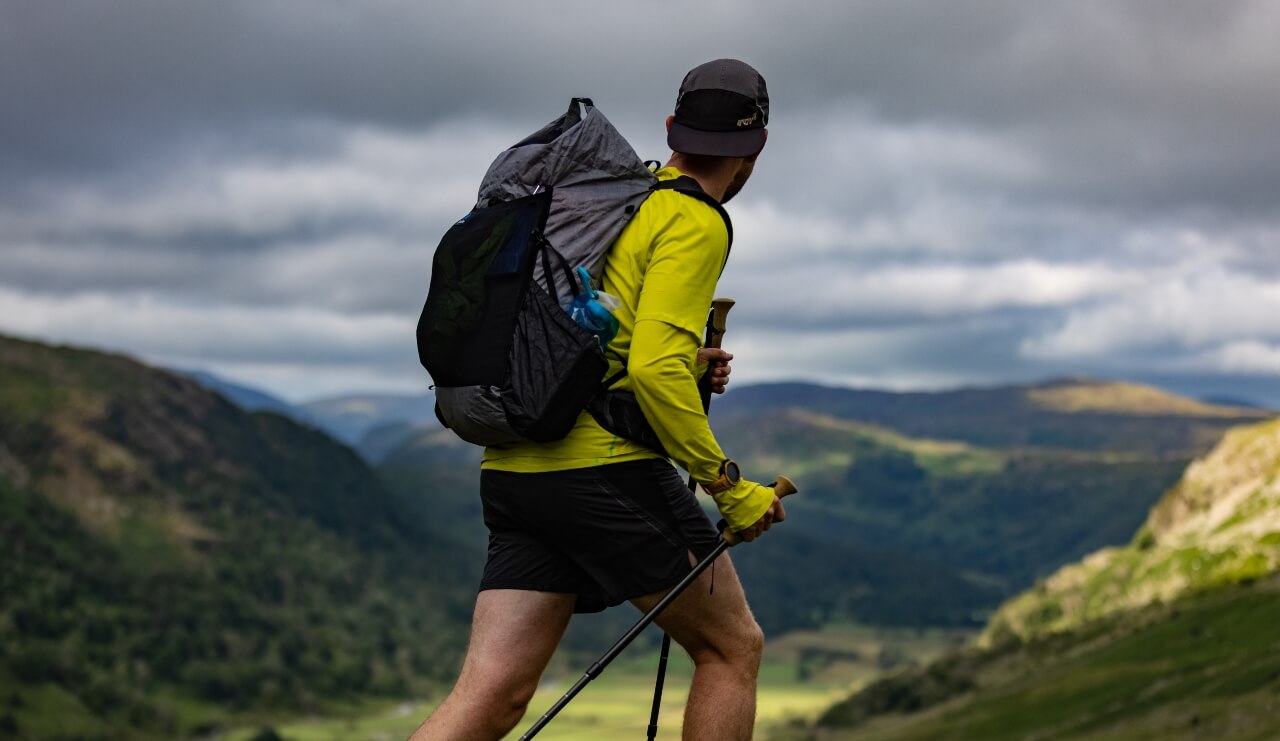
Want to transition from day hiking to multi-day hiking, but worried you won’t be fit enough? Fear not – here’s a training plan to get you ready for your next long-distance trail.
Multi-day hiking – any walk that takes longer than 24 hours, including at least one overnight stay - is well within the reach of every averagely fit person. All you need to do is slowly build up your strength, fitness, stamina, endurance, and mental fortitude. Soon you’ll be ready to take on the Pennine Way, Cape Wrath Trail, Hadrian’s Wall Path or whatever trail you’re dreaming of completing.
To help you along the way on this journey, INOV8 ambassador James Forrest – who has completed a myriad of long-distance walking adventures including hiking all 214 Wainwrights in 14 days and walking between the National Three Peaks in 17 days – is here to help with a comprehensive list of tips, tricks, advice and guidance. His training plan below is designed for a competent day hiker with reasonable fitness who is looking to step up from day hiking to bigger multi-day adventures.
IMPROVING YOUR BASELINE FITNESS
How fit are you, really? This is an important question to ask yourself before you start your multi-day hiking training plan.
Your baseline fitness will have a big impact on how much training you need to do, how long it will take you to reach the requisite fitness level, and exactly what type of training will help you most. Perhaps ask yourself – can I already walk 25km in a day without much difficulty? If yes, can I do it over rough terrain with a 10kg backpack weighing me down? And could I do it every day for 7 days in a row? These are the types of things you need to be thinking about when prepping for a multi-day hiking trail.
Of course, it goes without saying that if you are generally healthy with a good level of fitness, you will have a far better chance of coping well with a long-distance hiking challenge. To build up your overall holistic health, make sure you exercise regularly, eat and drink healthily, sleep well, and minimize stress. These four important strands, if looked after, will boost your energy levels, help you maintain a healthy weight, and ensure you have good cardiovascular fitness.

HOW TO BUILD STAMINA & ENDURANCE FOR HIKING
Before starting with the training plan specifics, here are a few general principles to remember:
- Don’t leave your training to the last minute
This is a sure-fire recipe for failure and disappointment. Instead, give yourself as long a lead-in time as possible, anywhere from 3 to 6 months should work. So if you are going on your adventure on August 1, you should start your training from February 1, or by May 1 at the latest. - Hiking is the best form of training
Most long-distance hiking experts believe in the same truth when it comes to training: the best way to train for a long-distance walk is to go on long, tough walks. Simple. This is because you will be building the right type of fitness and building up the right muscles needed for hiking. - But embrace everyday fitness too
If you think you can only train for hiking when you’re out in the hills of the Lake District or Peak District, you’re setting yourself up to fail, particularly if you live in a city. For many people, it’s useful to also focus on everyday exercise, anything from cycling to the office or working out in the gym to playing team sports or going for a jog. While it’s not as bespoke and tailored as hiking training, it will still be a big help and improve your base level of fitness. Often this type of exercise is easier to integrate around your job or family commitments too. If you have a ‘normal’ structure to your week, working Monday to Friday, then it will make more sense to do everyday exercise sessions during the week and then escape to the countryside for longer rambles at the weekends. - Don’t burn out too quickly
A more sensible approach is to incrementally increase your goals gradually, upping the distance, ascent, and intensity of your walks slowly every week over a few months, rather than expecting instant big leaps. Aim for small bite-sized improvements instead. - Replicate the realities of trail life closely
It would be silly to train in running trainers without a backpack, only to then find yourself on a multi-day adventure wearing a heavy 65L pack with sturdy hiking boots on your feet. The difference is big and could lead to problems. Instead, it’s sensible to train with the exact same backpack and exact same clothing as you’ll actually use on the trail. Try to also replicate the terrain of the trail you’re likely to experience too. Rather than hiking on tarmac roads, can you walk hill reps in a local park? - Use your multi-day hiking adventure as a training target
What is the distance and ascent of the longest day on your chosen trail? If it’s 25km and 500m of ascent, then this is a benchmark for your training. Aim to be able to achieve this distance – or, ideally, longer and higher – about a month prior to your trip. Don’t forget too that multi-day adventures are all about day-after-day endurance and stamina. If you can walk 25km for one day, it doesn’t necessarily mean you can do it for 7 days in a row.

6-MONTH TRAINING PLAN FOR A MULTI-DAY HIKE
This training plan is designed to help a competent day hiker with reasonable everyday fitness to build up the endurance they need for multi-day hiking.
Example Goal: to walk the 135km Hadrian’s Wall Path in 6 days, covering 22.5km per day with approx 200m of ascent per day.
Month 1
- 3 x 30-minute everyday exercise sessions (jog/run/cycle/gym/team sport) per week
- 1 x weekend walk of 20km in hilly country with a heavy backpack per week
Month 2
- 3 x 30-minute everyday exercise sessions (jog/run/cycle/gym/team sport) per week
- 1 x weekend walk of 25km in hilly country with a heavy backpack per week
Month 3
- 3 x 45-minute everyday exercise sessions (jog/run/cycle/gym/team sport) per week
- 1 x weekend walk of 30km in hilly country with a heavy backpack per week
- 1 x 3-day backpacking trip of 75km during one weekend
Month 4
- 3 x 45-minute everyday exercise sessions (jog/run/cycle/gym/team sport) per week
- 2 x weekend walks of 20km in hilly country with a heavy backpack per week
- 1 x 5-day backpacking trip of 125km one week of annual leave
Month 5
- 4 x 60-minute everyday exercise sessions (jog/run/cycle/gym/team sport) per week
- 2 x weekend walks of 25km in hilly country with a heavy backpack per week
- 1 x 3-day backpacking trip of 75km during one weekend
Month 6
- 4 x 60-minute everyday exercise sessions (jog/run/cycle/gym/team sport) per week
- 2 x weekend walks of 30km in hilly country with a heavy backpack per week
- 1 x 3-day backpacking trip of 75km during one weekend
Please remember that this training plan is meant as an example only and should be fine-tuned to your own needs, fitness level, and personal goals. You can easily increase or decrease the times and distances, for example, to tailor the plan to your needs.
As an aside, it’s also sensible to acknowledge that a training plan is simply a motivational tool – and one that can polarise opinion. You may find the structure and planning is useful for you, or you may find it a chore that sucks the pleasure out of hiking. Don’t worry either way. Ultimately, it’s about finding an approach that motivates you.

8 PRO TIPS: HOW TO BE BETTER PREPARED FOR YOUR MULTI-DAY HIKING ADVENTURE
1. Walk with hiking poles
Hiking poles will improve your balance, take the strain off your joints (knees, hips, and ankles), power you uphill, and increase sure-footedness on the downhill.
2. Choose the right pair of shoes (and break them in)
Traditional wisdom says you should have a sturdy, heavy, high-ankled pair of boots, but this thinking is largely out-dated. Aim for a lightweight, super-comfy, mega-cushioned pair of trainer-style boots that will help you smash out the mileage, without a single blister in sight. My personal favourites for a multi-day hike are the INOV8 ROCFLY G 390 hiking boots (GORE-TEX option also available).
3. Integrate walking into your everyday life
Instead of having to find the time for special training hikes, can you commute to work by walking or perhaps hike to the supermarket for the big shop rather than driving?
4. Give yourself a hiking goal
An excellent motivational tool can be a target to aim for, so perhaps you could give yourself a mega challenge, such as Country Walking Magazine’s 1,000-mile challenge (walk 1,000 miles in a year), or even a peak-bagging challenge such as the 214 Wainwrights in the Lake District?
5. Stave off the boredom
If you find your training walk monotonous and boring, why not bring the fun factor by hiking with friends, or listening to a comedy podcast?
6. Reduce the weight of your pack
When you’re packing for your multi-day hiking adventure, don’t be tempted to pack the kitchen sink. A monster 20kg pack will slow you down, make your back ache, and just ruin the all-round experience. Instead aim for 10kg or lower, and keep things fast, light, and nimble.
7. Build resilience
Multi-day hiking isn’t just a physical challenge, it’s a mental one too. Will you keep going when you feel tired and miserable, when your feet are aching and the rain clouds are circling? Building a strong, determined, tough mindset is vital therefore. This is easier said than done, but can be achieved by setting bite-sized achievable goals, focusing on successes, not being too harsh on yourself, and ultimately focusing on the positives.
8. Walk in all weathers
If you only train when the sun is shining, it will be a shock to the system when the torrential rain falls and the wind howls on your multi-day adventure. Instead, make sure you train in all weathers and your general resilience and hill hardiness will improve.
